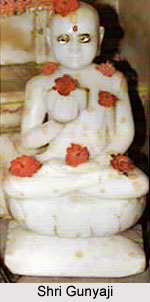 Gunayaji is a small village on Patna-Ranchi main road from where the temple is only 250 meters away. Gunayaji is twenty-three Kms from Pavapuri. Swetambara and Digambara Dharamshala are available in Teerth.
Gunayaji is a small village on Patna-Ranchi main road from where the temple is only 250 meters away. Gunayaji is twenty-three Kms from Pavapuri. Swetambara and Digambara Dharamshala are available in Teerth.
The idol of the temple, Shri Gautam Swami Maharaj is seated in a lotus posture. The colour of the idol is white in colour and the height of the shrine is 30cms.
In the history of Rajagirh, a holy shrine named "Gunashil Chaitya" has been described. Thus according to history that place may be "Gunayaji." The temple belongs to the times of Lord Mahavira. It is believed that Lord Mahavira visited this place several times and gave sermons seated in Samosarans. As per another opinion, this is the place where the first and the chief disciple of Lord Mahavira, Shri Gautam Swami achieved Kewal Gyan. Shri Gunyaji Teerth is regarded as very holy and significant for the devotees because it is contemporaneous to Lord Mahavira. Chaitya `Guniyaji` is a deformation of `Gunashil`.
The shrine of Shri Gunyaji Teerth is well connected to different places. Cars and buses can go up to the temple. The temple is about 3Kms from Navada Railway Station in Gunayaji village. From main road it is about two hundred meters, in the middle of a lake. The nearest bus stop to the temple is Gunyaji and the nearest airport is Patna.
This article is a stub. You can enrich by adding more information to it. Send your Write Up to content@indianetzone.com




















